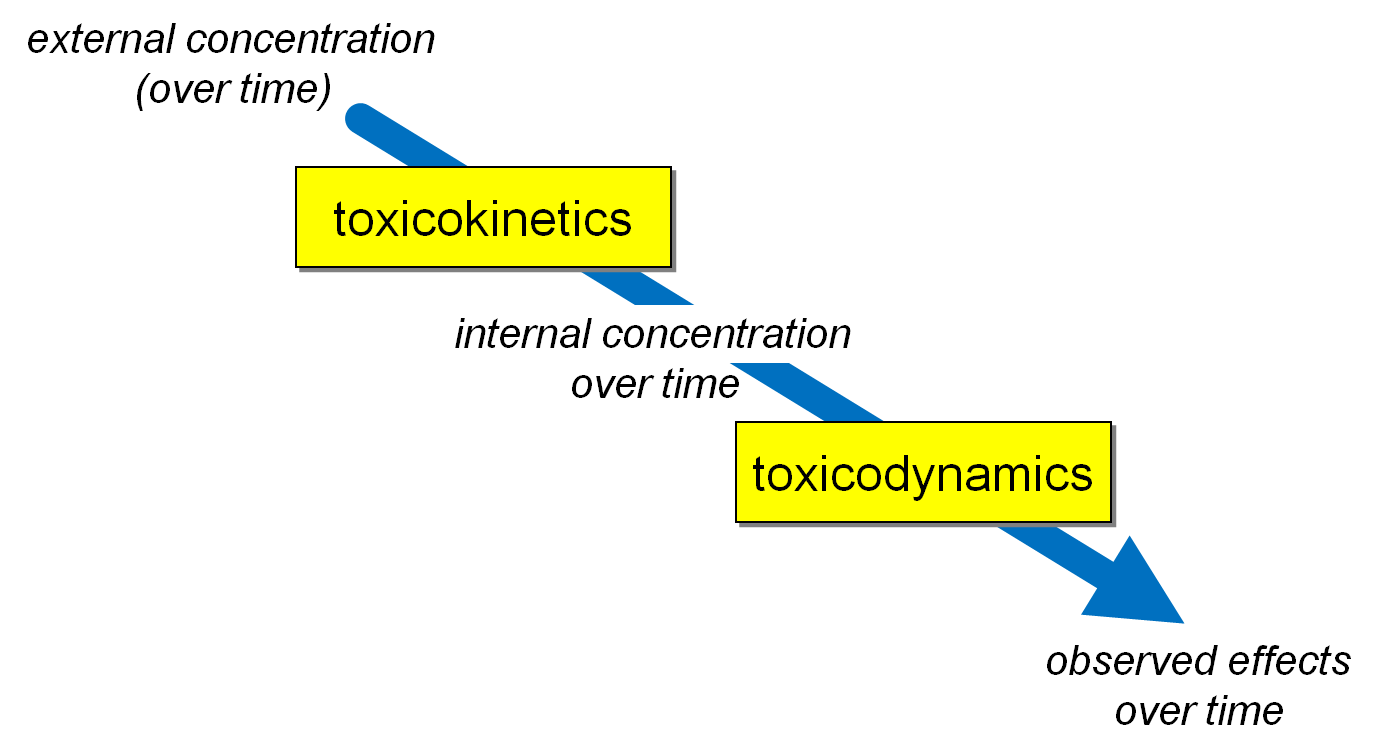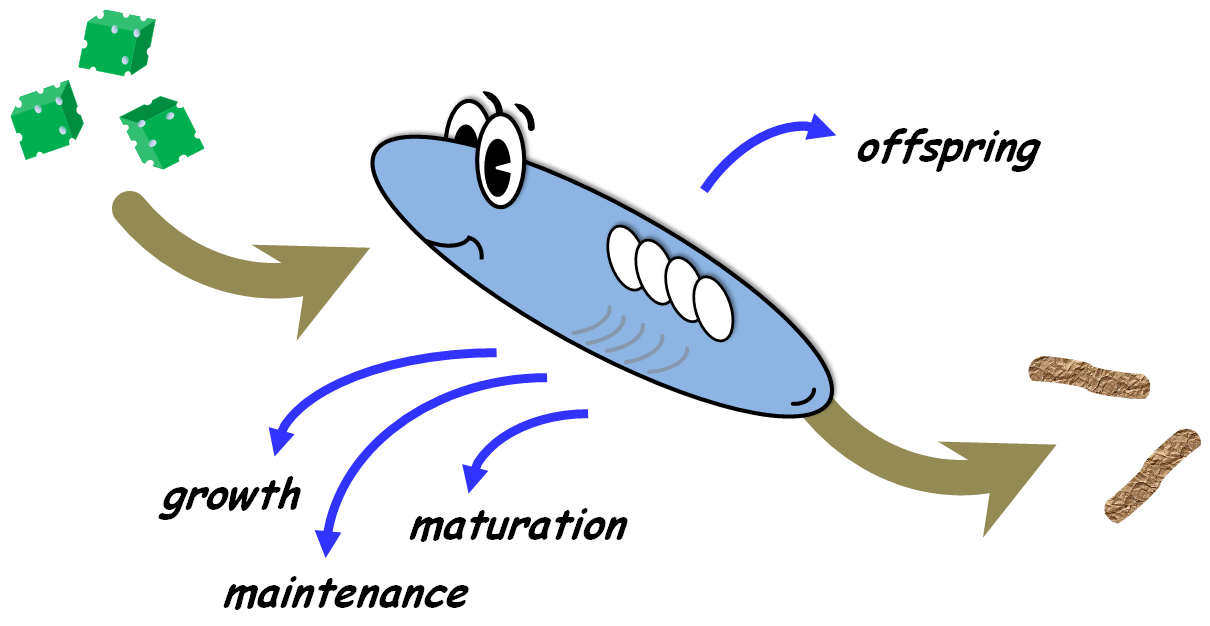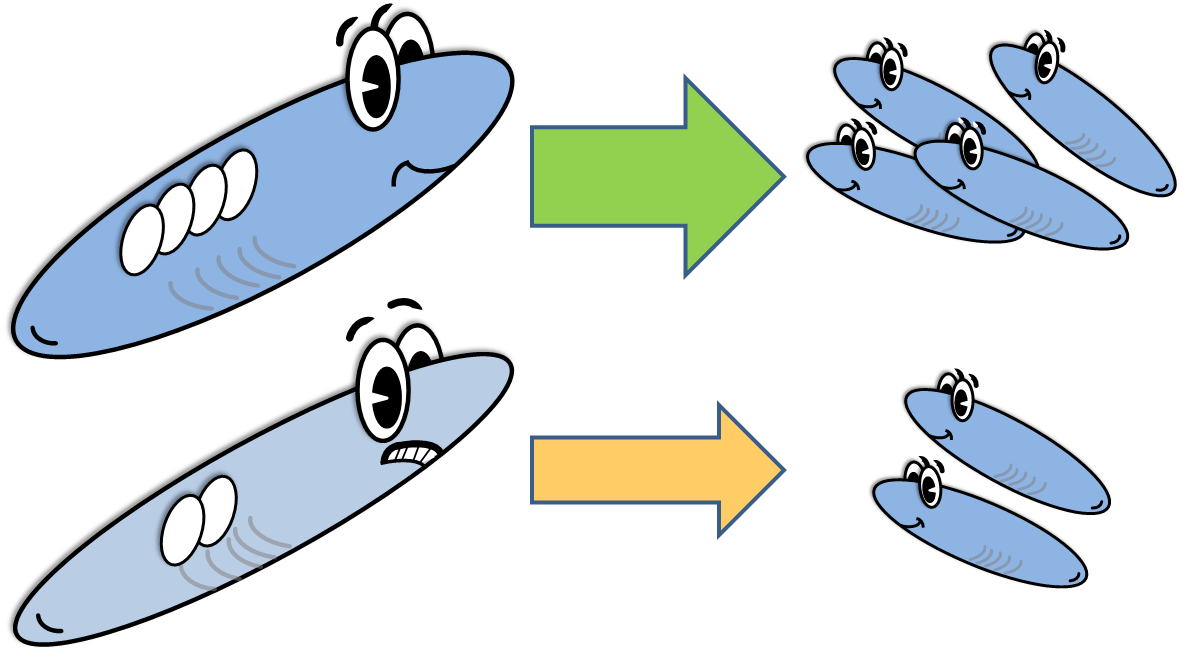
DEBtox information
Making sense of ecotoxicity test results

Main menu
Submenu
| |
||
 DEBtox information Making sense of ecotoxicity test results |

|
|
|---|---|---|
Main menu |
Submenu |
|
DEBtox information |
DEBtox information |
|
What is DEBtox?In the broadest sense, DEBtox is the application DEB theory (see below) to (eco)toxicological problems. Over the years, several things have been called 'DEBtox', and the first one was a piece of software belonging to the booklet 'The analysis of aquatic toxicity data' by Bas Kooijman and Jacques Bedaux in 1996. The principle is however much more general: I like to use the term DEBtox more broadly for all models that are strongly rooted in DEB theory and applied to (eco)toxicology. It is all about mechanistically linking (time-varying) external concentrations of a toxicant to the effects on life-history traits (survival, growth and reproduction) over time using DEB theory. Therefore, DEBtox ranks as a toxicokinetic-toxicodynamic (TKTD) modelling approach, and these methods are used to analyse toxicity data over time, and to predict effects under untested conditions. Check out DEBtox at WikiPedia (although this clearly needs updating). More recently, the term DEB-TKTD was proposed by Sherborne et al as an over-arching designation. We'll have to see how this nomenclature develops over time. |
|
What is a TKTD model?TKTD modelling follows the principle that we need both toxicokinetics and toxicodynamics to make sense of toxicant effects. Toxicokinetics is concerned with the link between external concentrations and internal concentrations in the body of an organism (in human toxicology, this field is termed pharmacokinetics). It thus accounts for processes like uptake, elimination, internal distribution and metabolism of the compound. The link between an internal concentration and the time patterns of effects that we are interested in is the realm of toxicodynamics (in human toxicology, pharmacodynamics). Linking TK and TD thus allows to mechanistically link external concentrations to effects over time. In modern TKTD models, TD is split up in two modules: damage dynamics and an 'organism model' (which in DEB-TKTD is a DEB model). |
 |
So what makes the DEBtox principle special?The DEBtox principle is a specific TKTD approach in which the toxicodynamic model is formed by a model based on Dynamic Energy Budget (DEB) theory. This can be any DEB model: the 'standard animal' model, a simplified animal model such as DEBkiss, a DEB-algae model, etc. When the model has a firm basis in DEB theory, I like to call it a DEBtox (or DEB-TKTD) model. The toxicant, after being taken up into the body, affects one or more metabolic processes in a DEB model. Examples of such processes include the maintenance costs per unit of structure, the assimilation of energy from food, or the probability to die. |
|
What is DEB theory?DEB stands for Dynamic Energy Budget theory, as developed by Bas Kooijman. In essence, DEB theory consists of a simple set of rules that specifies how organisms acquire energy and building blocks from their environment to fuel their life cycle, from embryo to death. The theory applies to all species on earth (and possibly on other worlds too). This theory is not just useful for ecotoxicology; there are also applications in aquaculture, sewage treatment, and much more. A readable conceptual introduction can be found in my e-book, which can be downloaded for free. This book is math-free; it is all about the background and the concepts (the technicalities are available in a separate document, as well as supporting information of various papers, see e-book page). The focus in the book lies on (invertebrate) animals. A more complete and thorough description of DEB theory is provided in the 2010 book of Bas Kooijman, which is also a much tougher read. This latter book is not free, but friendly priced. Check out the "Summary of Concepts" on the books homepage. For an introduction into the theory in the open literature, consult the papers of Kooijman (2001), Nisbet et al. (2000), Van der Meer (2006), or Jusup et al (2017). The latter is a comprehensive review on DEB theory. Or, check out the DEB portal or DEB at WikiPedia. In this YouTube video, Bas Kooijman introduces DEB theory himself. |
 |
Why do I need to consider energy budgets?The level of the energy budget is a pretty convenient level to work at. If we see that stressed mothers put out less offspring, that means that less energy is coming out. We thus have to ask ourselves: "where did that energy go to?" Was it never assimilated in the first place (the stress might be on feeding), or is there an additional drain of energy (e.g., to repair damage due to the stress)? Or perhaps, there is less offspring, but they are much heavier. These questions can be quantitatively assessed in an energy-budget framework, without focussing on the biological details of the organism, or details of the stressor's action mechanism. Knowing which energy-based process is affected by the stressor allows us to make predictions for other situations, e.g., when food is in limited supply. Of course, many researchers like to dive into the molecular details of the effect, but end up with something that is very complex, very data intensive, very species- and stressor-specific, and probably of little practical use. Others treat the organism as a black box, and use a descriptive dose-response curve, which is the more classical ecotoxicological approach. For many applications, in my opinion, the level of the energy budget is the best compromise between overly-detailed 'bioinformatics' and practically useless dose-response curves. |
 |
What is the advantage of DEBtox over descriptive dose-response curves?DEBtox uses all of the available information in its analysis. This includes the effects on all endpoints, for all treatments, and all time points. The result is captured in time-independent parameter values that provide insight into the mechanism of action of the toxicant, and allows for educated extrapolation to untested situations (e.g., a time-varying exposure in the field). In contrast, descriptive dose-response analysis leads to summary statistics like the NOEC, EC50, or LC50, which vary between endpoints and depend on the exposure time (a fact that is disguised because exposure time is standardised in the official test protocols). A summary of these problems is given in Jager (2011), and some nice illustrations can be found in Alda Álvarez et al. (2006) and Baas et al. (2010). Because of these issues, such simple summary statistics are poor indicators for toxicity, and anything derived from them (such as SSD's and QSAR's) will be of limited use. Is application of DEBtox really that simple?No, generally it is not. Because you dive deeper into your experimental data, you may discover that crucial information about your test species and/or the chemical is missing. Generally, a DEBtox analysis leads to new questions, but these questions are always more interesting than the original ones! Nice illustrations of the process from data to interpretation (and the associated problems) have been presented as case studies in the e-books and in Jager & Selck (2011). It is always a good idea to think about the data analysis before you set up the experiment, and it is optimal if you can return to the laboratory to address new questions that arise from the DEBtox analysis. |
|
What is the regulatory status of DEBtox?The DEBtox method is included in OECD guidance, next to more classical methods that derive NOEC and ECx. This guidance is also available as an ISO guidance. This guidance appeared in 2006 but does not seem to have inspired increased application of DEBtox in risk assessment. However, in recent years, TKTD modelling (incl. DEB) has been gaining interest in a regulatory perspective, especially in the area of plant-protection products (pesticides). Specifically, regulatory application in Europe is facilitated considerably by the 2018 EFSA opinion on TKTD models, which explicitly discusses DEBtox (and GUTS). For DEBtox, the EFSA working group judged "that these models are not yet ready for use in aquatic risk assessment for pesticides. Nevertheless, the DEBtox modelling approach is recognised as an important research tool with great potential for future use in prospective ERA for pesticides." Clearly, some more research, and in particular case studies, are needed (plus perhaps user-friendly software tools) before routine application will take off. In December 2019, an international workshop in Wageningen discussed how to proceed with integrating DEB-based TKTD modelling into risk assessment of pesticides. Note that the DEBtox method can also be used to calculate an ECx(t) for any x, at each time point t, which could ease the transition from dose-response curves to TKTD modelling (already in the first tier of a risk assessment). DEB-TKTD is also mentioned as a potential tool in the 2023 EFSA guidance for birds and mammals. |
 Participants of the 2019 'DEBtox' workshop in Wageningen, the Netherlands |
Are hazard models DEBtox models?This is a matter of taste. DEB theory applies the hazard concept for survival (i.e., that each individual has a probability to die, which increases with age and stress). Hazard models are thus consistent with DEB theory; when organisms do not grow, age or reproduce, the role of energetics is limited, and the probabilistic aspects may be assumed to dominate. Hence, a full-scale DEBtox model would reduce to a simple hazard model when only survival is considered as an endpoint. However, when there is no energy budget in sight, such as in simple models for acute toxicity, referring to a hazard model as a DEB or DEBtox model is misleading, in my opinion. A more general framework for simple TKTD models for survival is given in the "about GUTS" section. What happened to the DEBtox Windows software?That software is no longer offered or maintained. The underlying equations for sub-lethal endpoints contained a few errors (see Jager & Zimmer, 2012), and it was programmed in such a way that it was very difficult to keep up to date with newer versions of the Windows OS. The Matlab implementations for the BYOM-package, that you can find on this site, are much more flexible and up to date, but of course, also considerably less user-friendly. The Add-my-Pet (AmP) library also contains code for performing TKTD analysis, see AmPtox (it should be noted that the approach taken differs somewhat from the most recent DEB-TKTD insights, see Jager, 2020, and Jager et al. 2023). Work is/was underway for an R-package (and possibly even a GUI around it) for DEBtox; if more information becomes available, I will include it on the website. Where can I read more about DEBtox?On this website ;-). A thorough conceptual introduction can be found in my 'Making sense' e-book, which can also be downloaded for free. That book is all about the background and the concepts. The math is banned to a separate (and by now quite outdated) document for the diehards. For a general introduction in the open literature, consult Jager et al. (2006). For most practical applications, a simplified DEB model will be most useful. The latest incarnation was published in 2020 by me (Jager, 2020), which is an update of the version presented by Jager & Zimmer (2012). An up-to-date version of TKTD with a full DEB model was published by Jager et al. (2023), which replaces the mode description in Jager et al. (2010). However, I don't generally recommend this version for ecotoxicological questions (see also Romoli et al., 2024 for a comparison with the DEBkiss-based version of Jager, 2020). A list of publications on DEB models dealing with toxic effects is available here. Is there a course on DEBtox?The summercourse DynModTox focusses on DEB-based modelling in ecotoxicology with DEBkiss. This course is planned to run once every two years in Denmark. Check the course page for more info. The general DEB course focusses on the theory in all its width, but also includes some ecotoxicological aspects of the theory, and is a good entry into the world of DEB theory (note that DEBkiss, and the DEBtox model derived from it, will certainly not be treated in this course). |
|